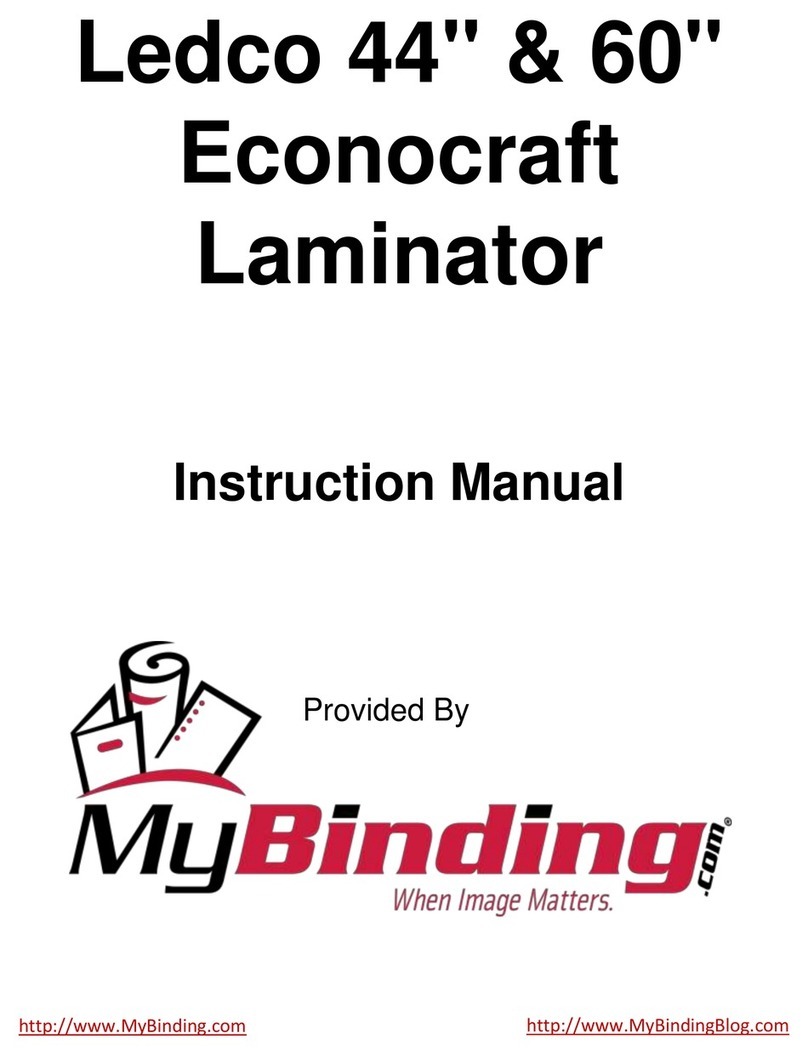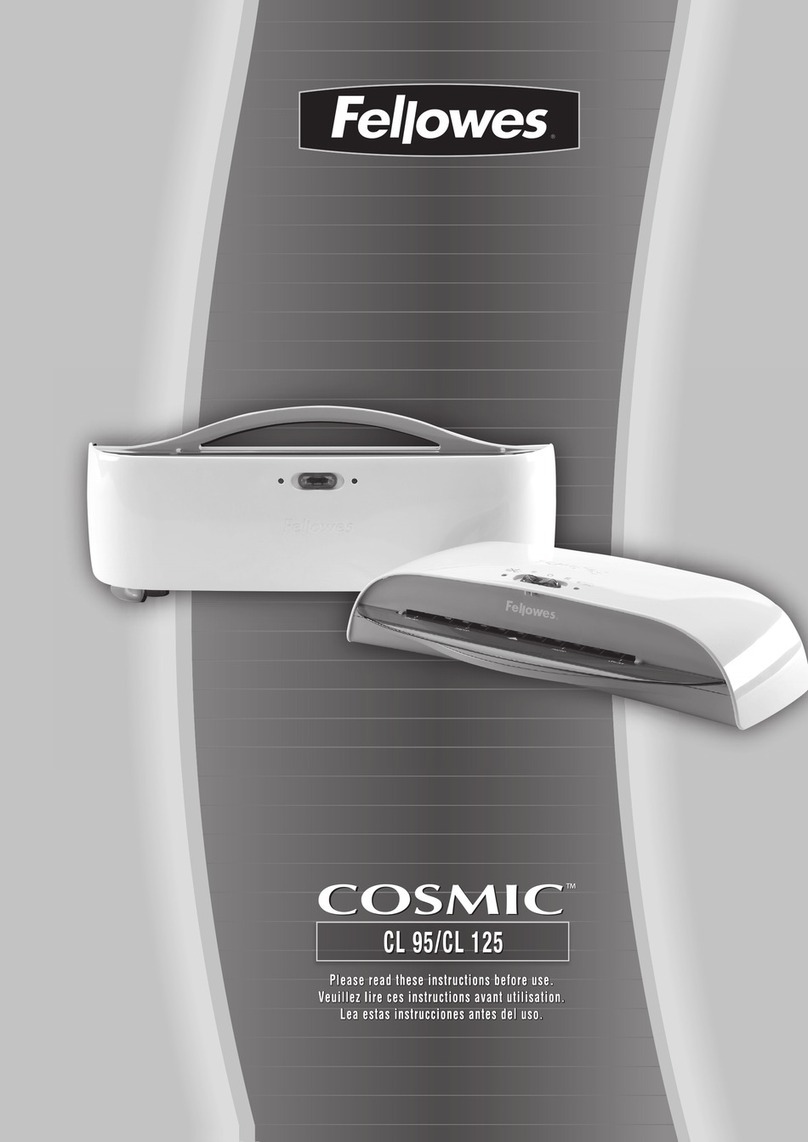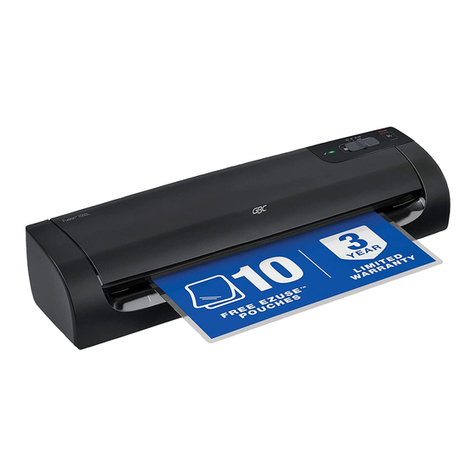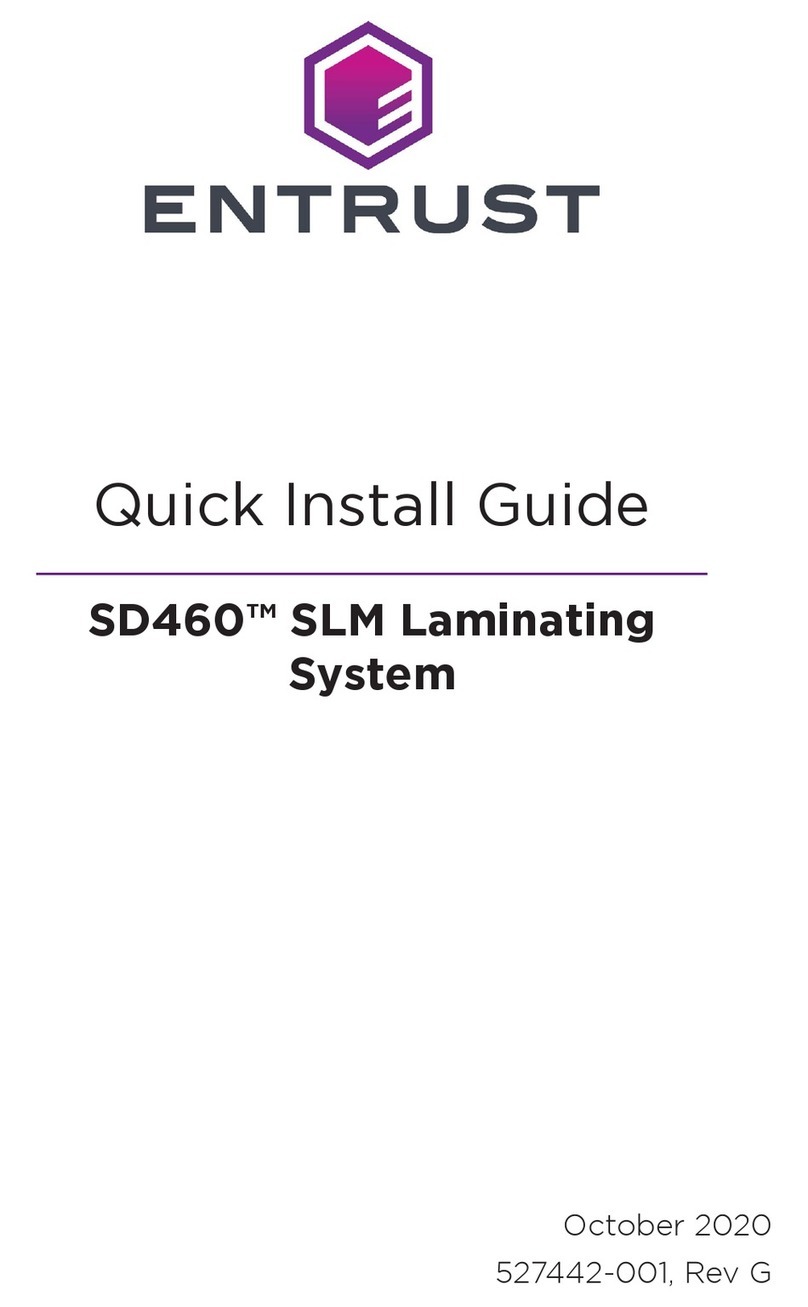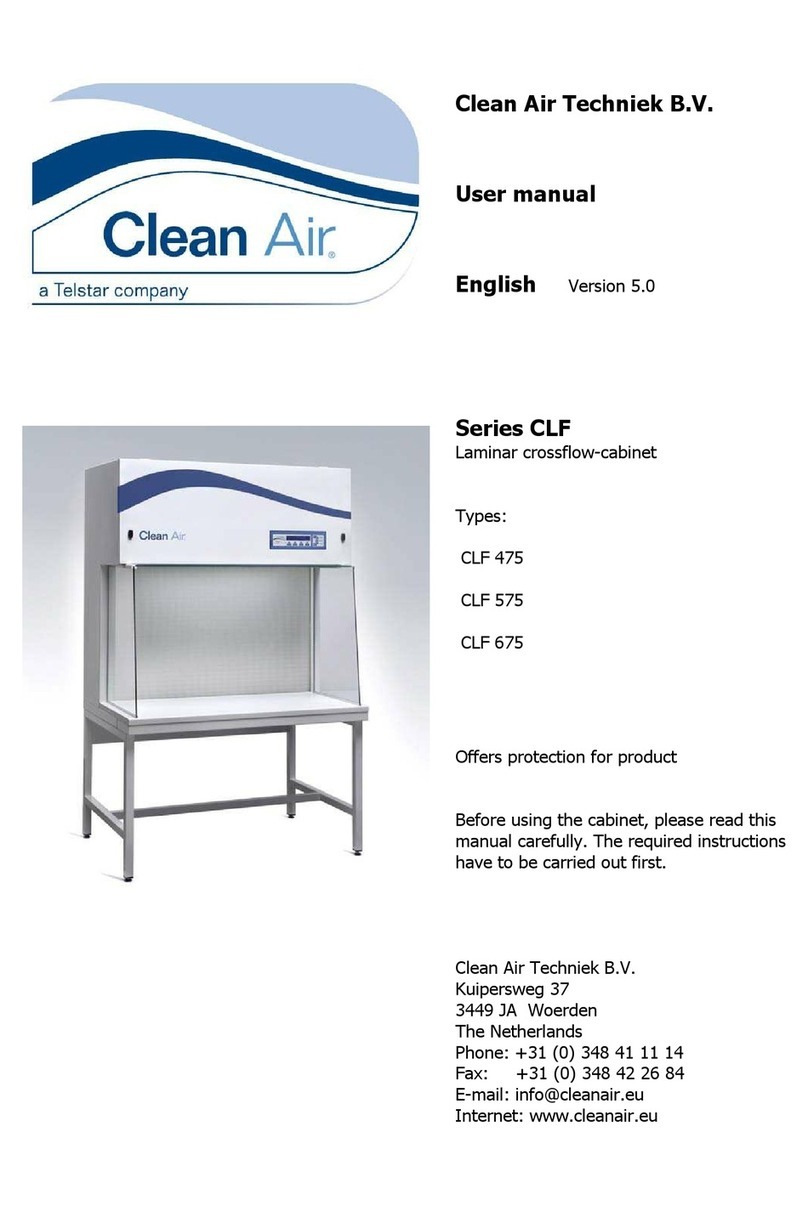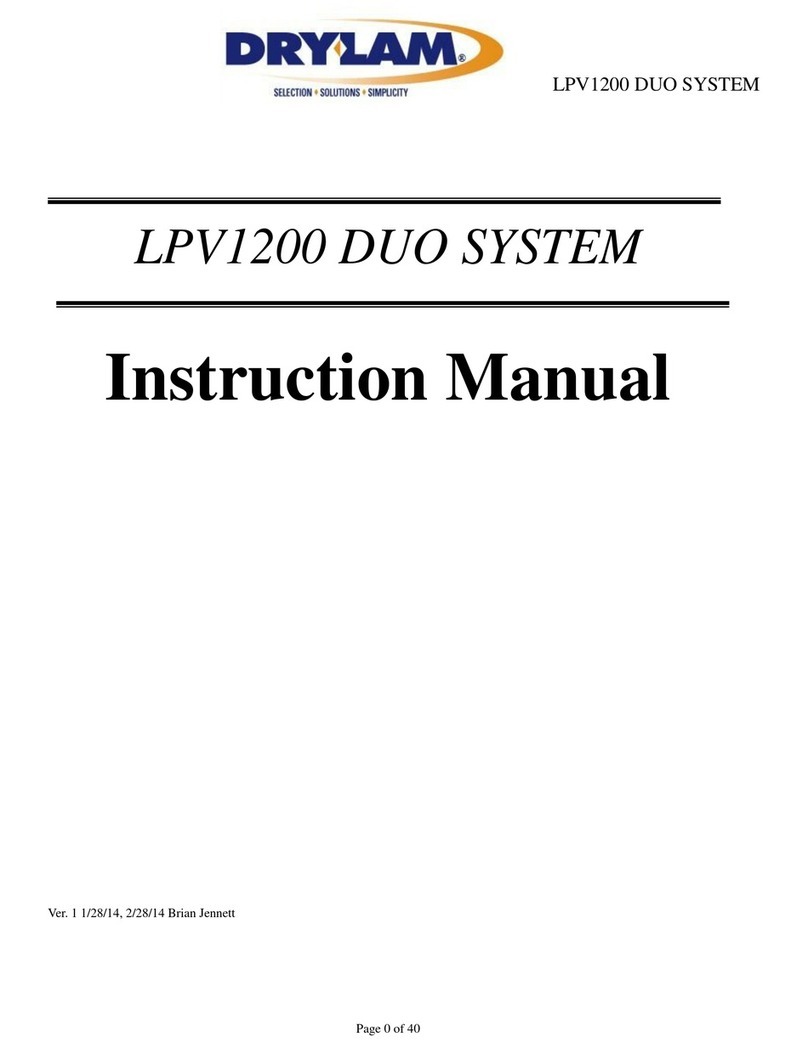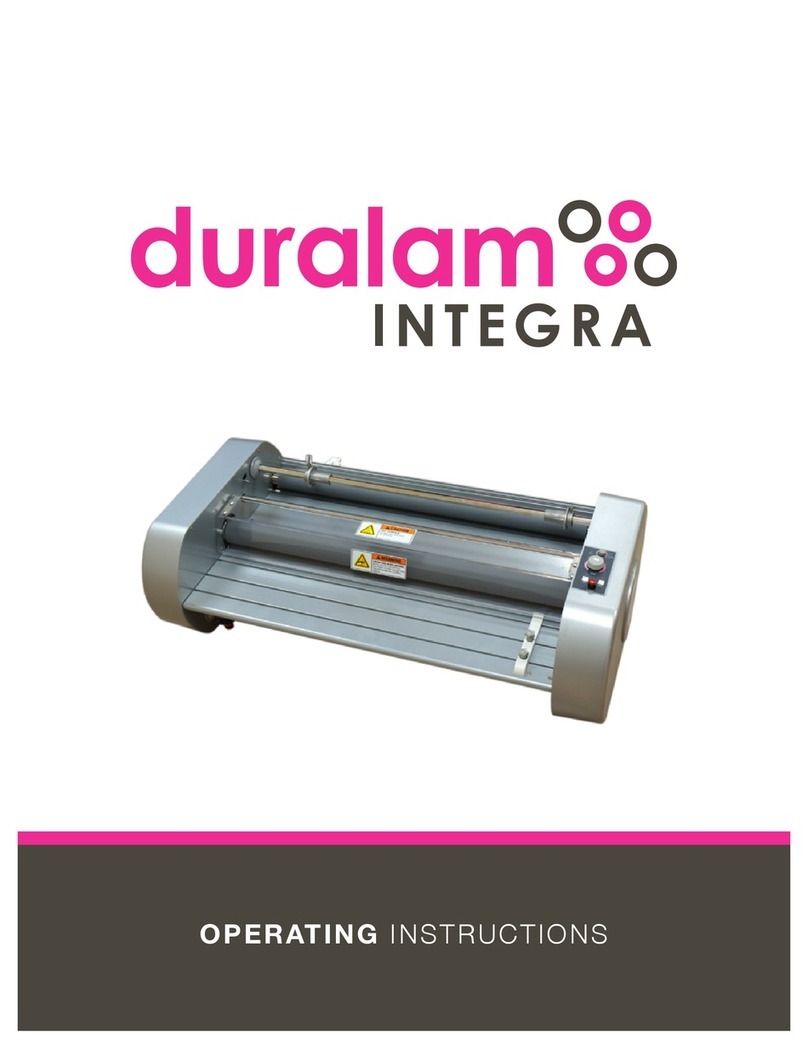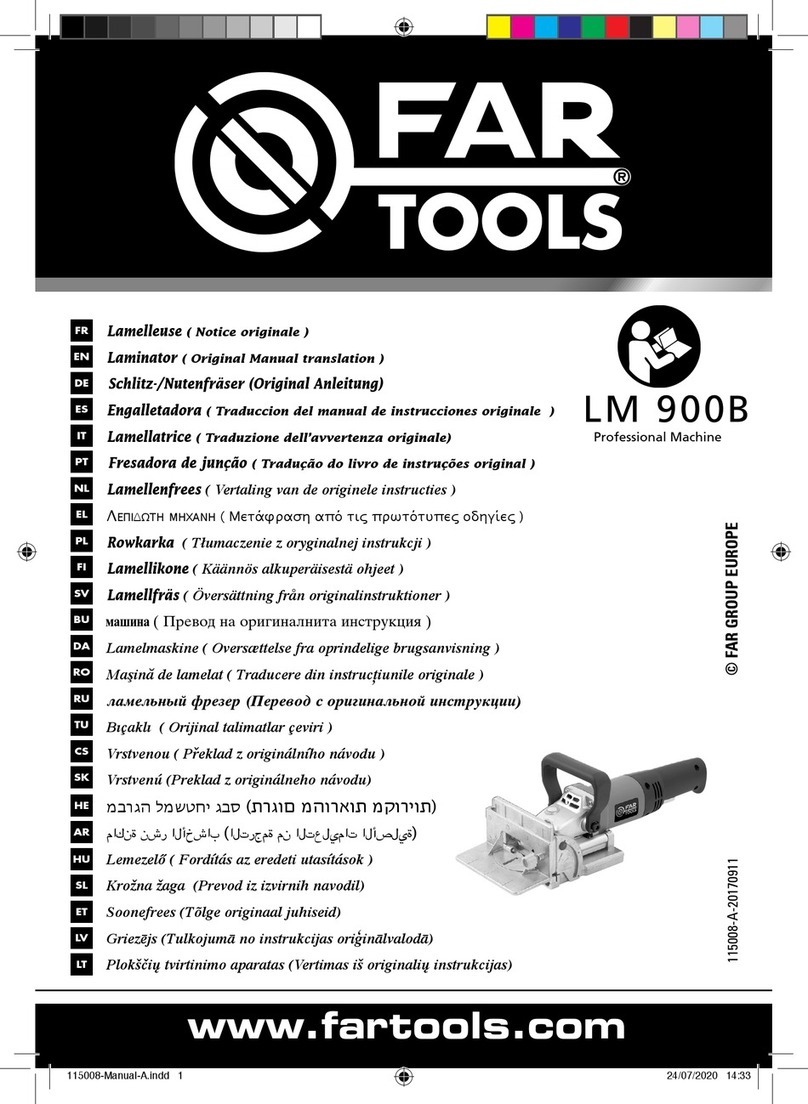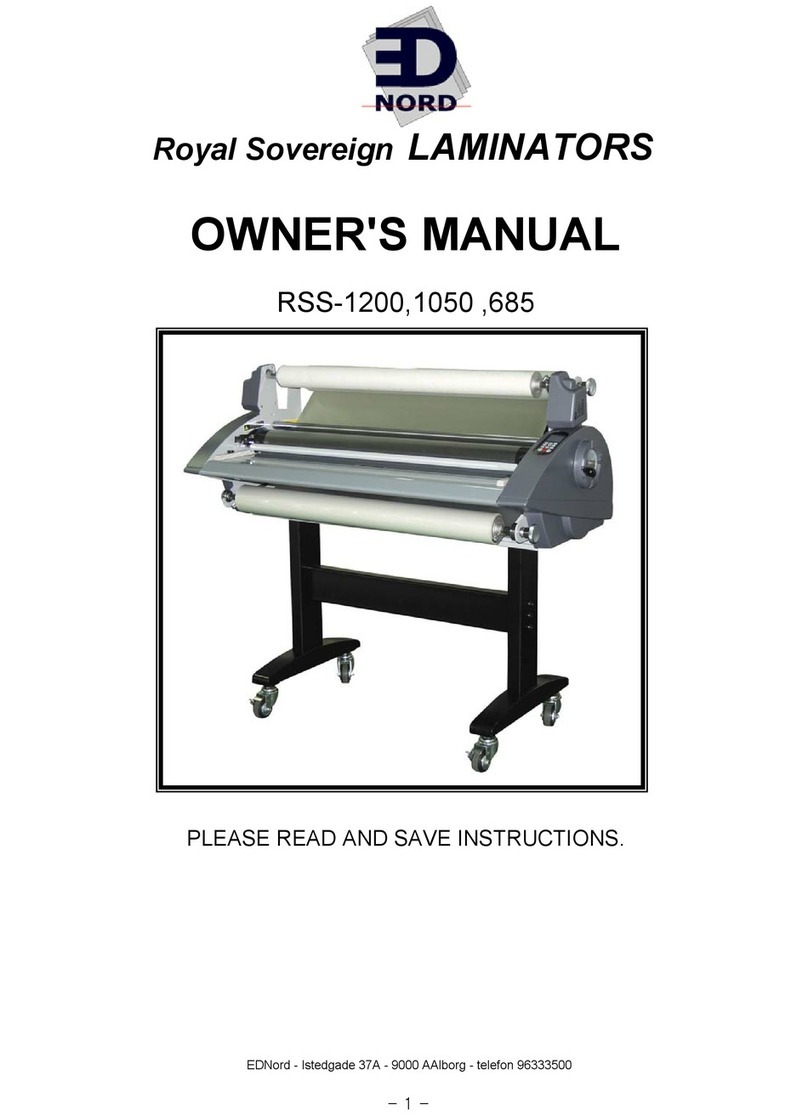BEIJING YC DIGITTECH YCY-215D User manual

YCY-215D LAMINATOR
U S E R ’ S M A N U A L
(2006)
BEIJING YC DIGITTECH LTD.
NOVEMBER 2006
WITH gratitude:
We thank you for your choice of YCY-215D Laminator
and you are our client who will achieve all round and
good service from us.
Attention:
Before you carry out installing, adjusting and operating,
please take some time to read the user’s manual carefully.
It will let you feel more easer and also to be sure that
machine runs normally.
YCY-215D Laminator control system
BYCD ® YCY-215D V1.00, 2003
© 1999-2003 BYCD BEIJING, CHINA

Contents
1 Safety directions
1.1 Safety prompt
1.2 Safety points before machine in operation
1.3 Safety points for operating machine
1.4 Prevent from seriously harm to body
2 Specification
2.1 Appearance of machine
2.2 Major technical parameter
3 Installation
3.1 Environment of install
3.2 Load and unload machine
3.3 Unpack and lay down machine
3.4 Connection between machine and main power supply
3.5 Connect motor and electromagnet with control cabinet
4 Operation
4.1 Directions of operation panel
4.2 Touch screen display and function select
4.3 Operate machine
5 Adjust, maintenance and eliminate faults on machine
5.1 Adjusting of system pressure
5.2 Adjust discharge
5.3 Maintenance of machine
5.4 Eliminate faults
5.5 List of sealing parts of hydraulic system
6 Electrical material
6.1 Main circuit diagram
6.2 I/O control diagram
6.3 Data collect
6.4 List of electric detail
6.5 Table of tips definition
6.6 Position diagram of electric parts
7 Spares, tools and material along with machine
7.1 Spares and tools along with machine
7.2 Material along with machine

1 Safety directions
1.1 Safety prompt
Design of the machine is in accord with safety rules for factory, the safety units
installed are in a position to protect the operators of machine and prevent any
danger by accident from machine itself. The operators should not just count on
these safety units and also have to read and understand the safety preventive
measures mentioned in the safety chapters of manual, then can start to run
machine.
Note: unsuitable operation might harm to people and other equipments around the machine.
1.2 Safety points before machine in operation
1.2.1Confirmation before turn on power supply
a. Make sure to do routine inspection well as required in the safety
chapters of manual.
b. Make sure that all safety doors of machine have been closed completely.
c. Make sure that all operating switches of machine are at correct operating
position.
1.2.2 Turn on power supply
a. Make sure that the rotation of the motor of oil pump is in a correct
direction. Look into it from the rear of the motor of low pressure oil pump, a
clockwise rotation is correct. Look into it from the rear of the motor of high
pressure oil pump, a counter clockwise rotation is correct.
b. Make sure that the indicate lights are normal.
c. Make sure that all safety units of machine, for example, the protectors, a
switch of safety door, an emergency stop button and grounding wires, all are
set correctly.
1. 3 Safety points for operating machine
The machine contains some heating parts, hydraulic press parts and high voltage,
therefore if the operator does not follow the safety points below, the machine might
have some potential dangerous situations.
1.3.1Operators have to be trained and carefully read the safety
points below as well as make sure to be acquainted with all means
of operation.
a. The operator has to know about means of operation of the machine well.
b. Do not take off the safety units, protectors, emergency stop button and
grounding wires of the machine.
c. Must know that how to stop machine in an emergency.
d. Do not try to stop the running machine with an article or your hands, in
particular heating parts.
e. More than 2 people together run the machine at the same time to be
definitely prohibited.
1.3.2 Only the qualified technician can do maintenance of electric
system, hydraulic system and mechanical system
a. Turn off the power supply before opening the door of electric cabinet.
b. Make sure that all of power sources are off, before taking off and
changing the electric parts.
c. Use the insulation tools in working.
d. Neither using a fuse that is beyond designed limit nor other metal wires.
e. When changing any wire, be sure to use as the same specification and
color as original.
f. Be sure that nobody runs the machine, before turn on the power supply.
g. Do not put anything on the control box or operating place, for example,
water and food.
h. Do not touch the switches of machine or any electric parts with wet
hands.
1.4 Prevent from seriously harm to body
a. Face to the machine to operate the panel in regular procedure.
b. Do not let your hand or any parts of body stretching into the running
machine when you bend down.
c. When the motor is rotating, don’t let other people be close to the
machine from behind or beside.
d. When the motor is rotating, don’t let your hand or any parts of body
reach into the domain of moving mould plate.
e. Follow the instruction to operate and maintain machines.
f. Do not examine and repair the mould plate when the motor is rotating
and heating.
g. Whenever leaving or having any adjustment of machine, be sure to turn
off the power supply.
h. If the machine is in abnormal condition, please inform to your chief or
instructor so that doing repair.

2 Specification
2.1 Appearance of machine
2.2 Major technical parameter
Applicable material: PVC or other plastic materials
Laminate layout: 4
8 or 4
6 or 5
5 or 3
5
The number of mould plates: 6each of cool and heat
Size of mould plates: 420
520 mm
Interval between mould plates: 50mm
Material layers (Max.): 15
Working pressure: 1~15MPa adjustable
Pressure precision:
0.5MPa
Heat temperature:
160
Temp. control:
1.5
Cylinder travel: 280mm
Hydraulic tank volume: 320 litre
Power supply: AC380V 50/60Hz 5-phase
Power: 21kW
Productivity (cards): 2400 cards per cycle at layout 4 x 8
Dimension: L2300×W700×H1800mm
Weight: appr.3500 kg
3 Installation
3.1 Environment of install
3.1.1
Install place The place should be far away from inflammables, there is
no combustible air in workshop, do not stack any goods behind the machine.
3.1.2
Ground requirement the machine should be installed inside a standard
industry factory building. The installed ground should be smooth and solid. A
depth of concrete pad will not be less than 200mm. If an installation is at
second floor or above, have to be sure that the bearing of floor meets
requirements.
3.1.3
Environment of install the workshop should be airtight, dustless and
have the ventilation installation.
3.1.4
The requirement of Power source Power supply is as AC380V/50Hz, 5
wires in 3-phase, ground wire is grounded reliably. Ground resistance < 0.1
.
Ground wire > 4 mm
2
3.2 Load and unload machine
Select lifting place based on the mark of gravity center. Keep the machine in
equilibrium throughout lifting. When using a crane to lift, need to select the
suitable sling rope. The rope should be pulled straight and try first to slide
down. Do not let the rope damage the outside and any parts of the machine.
3.3 Unpack and lay down machine
3.3.1
Check on the outer package of machine, if there is any damage, please
inform supplier. Otherwise unpack the package.
3.3.2
Level off body of machine with a level. If a floor is not smooth, try to put
some pads until making the machine level.
3.3.3
Open a cap of oil tank then fully pouring oil. Using a hydraulic wear oil of
46 #.
Note: Hydraulic oil must be accorded with the standards and make sure that the oil is
clean. An improper use or unclean oil could speed up the wear of oil tank and
hydraulic system.

3.4 Connection between machine and main power supply
Caution: Only qualified technician can make a connection of main power supply. A
voltage of power supply for machine is as AC380V, if get an electric shock, it would
cause some damages of machine or might lead to injuries and deaths on people.
Must be in accordance to a circuit diagram to connect a power supply of
machine on an assigned wiring position. The machine must be in safety
grounding.
Ground wire U (red) V (red) W (red) Zero N (blue)
Electrical board
1 2 3 N
Caution: never share a single ground wire by two machines or more.
3.5
Connect motor and electromagnet with control cabinet
Caution: Only qualified technician can make a connection of main power supply. A
voltage of power supply for machine is as AC380V, if get an electric shock, it would
cause some damages of machine or might lead to injuries and deaths on people.
3.5.1
Connect motor and electromagnet with control cabinet according to below
diagram.
Heat press
discharge
System discharge
Heat up
Cool up
Heat down Cool down
Motor of low pressure
oil pump
Motor of high pressure
oil pump
Zer
o
wire
Motor of low
pressure oil
pump
Motor of high
pressure oil
pump
Heat up
Heat
down
Cool up
Cool down
Heat
press
discharge
System
discharge
Definitio
n
N
blue
U
red
V
red
W
red
U
red
V
red
W
red
L L L L
L L
Wire
No.
N
019
020
021
19
20
21
54
55
56
5
7
Tip
1 2 3 4 5 6 1 2 3 4
3.5.2
After connecting motor and electromagnet with control cabinet, then
checking a rotation of motor of oil pump, the rotary direction should be as the
same direction as the arrow point. The way to check the rotary direction of
motor: Press the start button of pump, then pressing the stop button at once.
See if the rotary direction is correct, if it is not, swap the places of 2 input power
wires of AC380V. Repeat doing as indicated above. Make sure that the rotary
direction of motor is correct. The motor of high pressure oil pump is counter
clockwise rotation, the motor of low pressure pump rotates clockwise.
Caution: Be sure never let the motor rotate on incorrect direction more than one
minute.

4 Operation
4.1 Directions of operation panel
4.1.1
Illustration of operation panel
4.1.2
Function of push buttons
1
Power switch (knob switch) Power switch is mounted on the right side of
control cabinet. When the switch points at the position 1, the power supply is
connected through, the system is power on and the power indictor lights; points at the
position 0 to cut off power, the indicator off.
a. When power is on, all of electrical equipments and hydraulic system are
in a state of stand-by.
b. When need to stop the machine, usually just turn the knob to the
position 0; if no work for a long time, pull off the power plug.
c. Only this switch is at the position 1, all of electrical equipment and
hydraulic system are able to work.
2
Heating button(self-lock button) Press the button, the heat press
plates start heating and the heating indictor is lighting; press again (reset) to
stop heating and the heating indictor light is off. Auto/man all are effective.
Note: it can heat only in selecting work, otherwise PLC alarms. If PLC alarms, cut
off power then restarting.
3
Heat press start button (return button) Under automatic mode, press
down this button for 1 second, auto-cycle starts; automatically finishes one work cycle
based on the set pressure and set time. Press once again to start second cycle. It is
effective at automatic mode.
4
Cool press start button (return button) Under automatic mode, press
down this button for 1 second, cool press auto-cycle starts; automatically finishes one
work cycle based on the set pressure and set time. Press once again to start second
cycle. It is effective at automatic mode.
Note: when the heat press system compensates press, or heat press plates are going
up/down, cool press action does not start until heat press action is finished. When cool
press is acting, if heat press compensates press or up/down, the action of cool press
will be suspended, after the action of heat press is finished, the action of cool press
acts continuously.
5
Emergency Stop button In an emergency situation, can press the
button to cut off heating and the motor of oil pump.
a. If there is any abnormal status in works, press this button immediately to
stop the machine, so that find out the reason caused the abnormal status.
b. After eliminating fault, turn the button in clockwise. When the spring
clicks springing back, stop turning and release the button. It is relieved of
emergency stop, self-lock resets.
c. After terminating an emergency stop, press the start button to restart
operating.

4.2 Touch screen display and function select
4.2.1
Initial display
Turn the power switch, after power supply is on, a display is showed as below:
Touch to pop up a number keyboard, enter secret code 2222,
then popping up 4 selection menus:
Touch to show a selection work display:
Choice
Choice Work
4.2.2
Selection work display
Touch to go into the work 1 display.
4.2.3
Work display
4.2.4
Amend work parameter
Work parameters include heat temperature, the number of pressure level,
pressure and holding time of each pressure level. Touch to open
Work 1
Choice

the number keyboard, then after entering the secret code, pop up 4 selection
menus. Touch to go into the display of amend work parameter:
Select work No. first when amending parameters, work 1 is selected as above
display, then doing as below procedure:
a To amend temperature setting: after touching temperature value (100.0),
pop up the number keyboard as below fig.:
Touch relevant number, then touching ENT to confirm input and the number
keyboard is closed.
W-Para
Note: temperature range is as 0.0 – 160.0
Operation of number keyboard:
Amend: CR, touch CR to delete entered number.
Cancel: ES, touch ES to close the number keyboard
Confirm: ENT, touch ENT to confirm entered number, the keyboard is closed.
Move keyboard: at first touch top of board then touching a position moved to,
the keyboard is going to be moved to the position second touched.
b To amend the number of pressure level: touch value (4) of pressure level
to pop up the number keyboard, then touch relevant number, last touch ENT to
confirm input, the keyboard is closed.
Note: the number of pressure level range is among 1 – 4.
c To amend pressure setting: touch value (1.0) of pressure setting to pop
up the number keyboard, then touch relevant number, at last touch ENT to
confirm input meanwhile the keyboard is closed.
Note: pressure setting range is: 0.0 – 15.0 as well as 1
st
pressure level <
2
nd
pressure level < 3
rd
pressure level < 4
th
pressure level; 1
st
pressure
level > pressure precision +0.3.
d To amend time setting: touch value (10.0) of time setting to pop up the
number keyboard, next touch relevant number, then touching ENT to confirm
input, the keyboard is closed.
Note: time setting range is as 0.0 – 99.9.
e After finishing amend and confirm it is correct then touching
to go back the work selection display.
Note: the work parameters are only effective at this work.
4.2.5
Amend system parameters
The system parameters include pressure coefficient, pressure precision and
temperature control parameter. Touch to pop up the number
keyboard, then enter secret code
, pop up a menu of 4 selections, touch
t o to enter into a display of system amendment:
RETURN
S-Para
Choice

a To amend pressure parameter: eliminate an appearance of pressure
overdoing by amending pressure parameter, normally set this parameter
among 0.80 – 1.00, the increased or decreased value of each amending is not
bigger than 0.02. This value is already set at factory and do not change it rashly.
If the value is bigger, pressure may overdo, otherwise if smaller, pressure may
not reach to the setting value. It is ordinary better to adjust pressure by 0.3MPa
higher than setting.
Note: pressure parameter range is 0.80 – 1.00.
b To amend pressure precision: to determine the pressure at starting
compensating pressure by amend pressure precision, ordinary set the value as
0.3 – 0.5. For example, set pressure to 5.0MPa and pressure precision as 0.3,
when pressure is down to 4.7MPa, the hydraulic system will automatically
concentrate pressure to 5.0MPa. The hydraulic system will be easy to vibrate
when this value is smaller than 0.3. Recommend to set the value as 0.3.
Note: pressure precision range as: 0.3 – 0.5.
c To amend temperature control parameter: to change rising speed and
control precision of temperature by amending temperature control parameter.
Touch to enter into the display of amending temperature control
parameter.
Temperature control parameters have Kp, Ti and Td. Kp affect speed of
temperature rising, Ti affect temperature precision and Td affect time of taking
by temperature curve approaching setting value. Increase Kp, decrease Ti and
Td will quicken response, otherwise decrease Kp, increase Ti and Td will slow
down response. It should be around 10% by each adjusting, then making
amendment according to curve variation. Kp, Ti, Td have been set at factory, do
not amend it without PID experience. Maintenance person must take Kp, Ti and
Td on record.
Note: do not amend temperature control parameters rashly.
T-Para
e After amending and confirm it is correct then touching to
go back the work selection display.
Note: system parameters are effective on all of works.
4.2.6
Curve
Touch to show the immediate pressure and temperature system
detected in the form of curve.
Abscissas show time, ordinates show pressure or temperature, data in last 30
minutes are held.
Touch to return to work display.
RETURN
CURVE
RETURN

4.2.7
Detect status
Touch to display the status and data of input and output detected
by system.
Correspondence relation between voltage and temperature:
Voltage (v)
0 2 2.8
3 3.1
3.3
3.6
3.8
3.9
4.2
5
Temp.(
)
0 72 100
108
110
120
130
135
140
150
180
Correspondence relation between voltage and pressure:
Voltage(v)
0
0.25
0.50
0.75
1.00
1.25
1.50
2.00 2.50 3.75
5
Pressure
(
) 0
1 2 3 4 5 6 8 10 15 20
Input and output status:
Emergency
stop
Start
Heat
Lower
limit
Oil pump
Up
Down
Quick
Heat 1 –
heat 6
0
Emergency
stop
Stop
Stop
Stop
Stop
Off
Off
Quick
Off
1
Run
Running
Heat
Running
Run
Up
Down
Slow
Heat
STATUS
Touch , system returns to work display
4.2.8
Manual
Touch , then pop up the number keyboard, enter secret code, pop
up 4 selection menus, touch , goes into manual display:
a It will stop automatic circulation that shift running to manual mode, it is
necessary to press the start button again for doing work if return to running from
manual mode.
b Touching keys are holding keys, touch once to work, touch once more to
stop.
c To move the mould plates up by manual operation, need to touch
and simultaneously. It is the same at down move.
At this time, the plates slow up or down.
d Touch , the heat pressure plates will move quickly. It is
same for cool pressure.
e Touch to shift system into select status, so that observe
about input information. At this time from the display of select status return back,
it still go back to manual display, not work display.
f Touch , the system returns to work display
MANAUL
H-H-Pum
Heat Up
Heat Ft
STATUS
RETURN
RETURN
Choice

4.3 Operate machine
4.3.1
Automatic operation
a Push down “Power” button, power indicator is on, system is electrified
and an initial display is showed.
b Touch “Choice” to enter work display.
c Touch W-Para key to enter parameter setting display, separately set
temperature, pressure and time then touching Return key to return to work
display.
d Select work number of heat pressure, check parameter and see if
correct.
e Heat Push down Heat button, heating indicator is on and start to heat.
To stop heating, press Heat button again, heating stops, a heating indicator is
off.
Note: to shorten heat time, can move up plates to heat.
Attention: only after selecting work, then in a position to heat, otherwise PLC alarms.
After PLC alarms, turn power off then re-electrifying.
fHeat pressure when temperature reaches at setting, place materials,
push down Heating button, the plates move up, pressing and compensating
press. When setting time is up, the plates automatically move down, a single
cycle of heat pressure is finished.
g Cool pressure check whether the parameters are correct. Place
materials, press down Cooling button, the mould plates move up, pressing and
compensating press. When setting time is up, the plates automatically move
down. A single cycle of cool pressure is finished.
h If on accident, press Emergency stop button to exit.
Note: Before starting lamination, should adjust a position of photoswitch. When the
mould plates move up at this position, the move speed will slow down to ensure slowly
pressing. It is better to normally adjust a gap between the material on top layer and
plate above it to 5 mm. If materials’ depth is changed, need to readjust the position of
photoswitch. Cool press and heat press are the same.
4.3.2
Manual operation
(1) When doing machine adjustment, all of start/stop of motor of oil pump, the
mould plates up, the mould plates down, start/stop of motor of water pump and
heating of plate of each level are able to operate independently. Above actions
can be done through “Manual” interface
(2) When the machine is running, heat press is in working, if need to manually
operate plates to move up or down, can touch or
area to pop up the up or down button, so that achieve the plates up or down
through manual operation.
At any time to select Work No., amend Work Para, amend System Para and
carry out Manual operation, all of these need to touch Choice to go into the
relevant display, then enter secret code 2222, pop up 4 selection menus.
Heat Press
Cool press

All of them need to return to the work selection display:
5 Adjust, maintenance and eliminate faults on machine
5.1
Adjusting of system pressure
Note: adjusting work of system pressure done by hydraulic engineer.
5.1.1
System pressure is divided into the system pressure of high pressure
and the system pressure of low pressure, the adjusting of each of system
pressure is to be done by adjusting the pressure-regulating valve of relative
system. It has been done well before shipment, no touch in an ordinary
situation. Regulate value of system pressure of high pressure is 15MPa.
Regulate value of system pressure of low pressure is 2.5MPa.If need to adjust,
do it with reference to below figure.
Adjust system pressure
of high pressure
Adjust system pressure
of low pressure
Adjust discharge
5.1.2
Adjust system pressure of high pressure:
a. loose the jam nut of handle of pressure regulating valve;
b. turn the handle of regulating valve clockwise to increase pressure, turn
counter clockwise to reduce pressure;
c. be suspended for a moment on every adjustment of rising by 2 –3 MPa,
when pressure is stable, go on to adjust;
d. adjusting to 15 MPa then tightening the jam nut, adjusting is completed.
5.1.3
Adjust system pressure of low pressure: First adjust system pressure of
high pressure to 0, then in accordance with the above-mentioned steps to
adjust system pressure of low pressure to 2.5MPa.

5.2 Adjust discharge
Discharge has been adjusted right at the factory. Do not adjust in general
condition. If it is necessary to adjust, do it refer to the above diagram. Turn the
handle in the direction indicated by fig. on it. After finishing adjust, tighten the
jam nut.
5.3 Maintenance of machine
Item
Substance and manner of maintenance Period
1 Machine must keep clean and dry, regularly clear and
clean various positions of mechanism, 1/wk
2 It is necessary to clear and lubricate various movable
parts (various guide pillars) regularly. 1/wk
3 Check electrothermic tubes whether have some
damage, for this to survey the value of resistance at side
of contactor. If abnormal, change.
1/wk
4 Check various screws and nuts of connecting and tight
to see if loosed, in the light of conditions to tighten or
change.
1/2wks
5 Check various connection of wires to see if loosen or
cracked, then reconnecting or changing wires. 1/month
6 Overall check all of hold-down bolts, see their conditions
to tighten or change. 1/6months
7 Environment around the machine must be clean, dry
and no pollution. Long term
8 Often observe the altitude of surface of hydraulic oil,
when lower than 3/4, fill up promptly. Often
9 Often observe the temperature of hydraulic oil, it should
not be higher than 60
Often
10 After the machine runs for 1 year, should change
hydraulic oil, which grade is as 46# wear hydraulic oil. 1/year
5.4 Eliminate faults
Appearance
of faults Elimination ways
Appearance1
Laminator can not hold pressure
1.Check various positions of oil pipes and connectors of pipes
between hydraulic cylinder and integrated unit, if there is any oil
leakage, then changing pipes, combined gaskets or “O” sealing
washers that are damaged.
2.Change hydraulic lock.
3.Check the position between pressure gauge and integrated unit, if
there is any oil leakage, make a correspondent treatment.
4.If there is no problem on what above mentioned, check inner
sealing washers of cylinder to see if damaged and make a
correspondent treatment.
5.Hydraulic oil is unclean, refilter it.
Appearance2
Pressure of hydraulic system
very low or no pressure
1.As appearance 1.
2.Check the conjunctions of various valves and integrated unit, if
there is any leakage, treat correspondently.
3.Check the pipe and joint between the outage of oil cylinder and
integrated unit, if there is any leakage, treat correspondently.
4. See if oil in the tank is enough and treat it correspondently.
5.If no trouble on the appearances above mentioned, then changing
hydraulic pump.
Appearance3
Temperature
rising of heat
1.Check electrothermal tubes to see if there is short or broken circuit,
treat correspondently.
2.Check temp. sensor to see if work correctly.
3.Check contactor and circuit, treat correspondently.
Appearance4
Detected temp. are abnormal.
1. If temp. indicates 180
or minus or deviates from indoor temp.,
check thermistor, if damaged, change it.
2. Check connection wire of temp. transmitter.
3. If transmitter is damaged, change connection wire to stand-by
contact, when changing connection, care about the contact of sensor
must be correct; output tip of transmitter are changed
correspondently.
3. Change the transmitter.

5.5 List of sealing parts of hydraulic system
5.5.1
Sealing of hydraulic pressure cylinder
No.
Name Code Material Specification
Qty.
1 Support ring GB1235-76 poly-formaldehyde
D=220
2.5
25
2
2 Support ring GB1235-76 poly-formaldehyde
D=165
2.5
25
2
3
O Sealing washer
GB 1235-76 Rubber I-4 120
5.7 1
4
O Sealing washer
GB 1235-76 Rubber I-4 220
5.7 1
5 Piston sealing OK0220 00701 polyurethane 220
199
8
1
6 Dust ring A5G030 N3587 polyurethane 160
199
8
1
7 Rod sealing OD1600 polyurethane
160
175.5
6.3
1
8 Rod sealing BSG085 P5008 polyurethane
160
185
18.2
1
5.5.2
Hydraulic station
No.
Name Code Material Specification
Qty.
1
Combined sealing gasket
JB982-77 Combined part Gasket 16 2
2
Combined sealing gasket
JB982-77 Combined part Gasket 20 1
3
Combined sealing gasket
JB982-77 Combined part Gasket 22 16
4
Combined sealing gasket
JB982-77 Combined part Gasket 33 4
5
Combined sealing gasket
JB982-77 Combined part Gasket 14 10
6
Combined sealing gasket
JB982-77 Combined part Gasket 42 2
7
Combined sealing gasket
JB982-77 Combined part Gasket 18 12
8 O Sealing washer GB1235-76
Rubber 20
2.4 6
9 O Sealing washer GB1235-76
Rubber 35
3.1 1
10 O Sealing washer TUO Rubber 12
2 4
11 O Sealing washer GB1235-76
Rubber 16
2.4 10
5.5.3
Sealing of pipe
No. Name Code Material Specification Qty.
1 O Sealing washer
GB1235-76 Rubber I-4
16
2.4 8
5.5.4
Sealing of meter pipe
No. Name Code Material Specification Qty.
1 O Sealing washer
GB1235-76 Rubber I-4 6
1.9 2
6 Electrical material
6.1 Main circuit diagram
Motor of high press
oil pump 2.2kW
3
2
1
U
Filter
FU
W
VN
6
45
97 8
QS
QF2
KM1
SSR1 SSR2 SSR3
16 17 18
19 2120
FU5
PE DC24V 1.5A
DC24V 4.5A FU3
220V
N
24V+
24V-
24V+
24V-
FPO
C16T
FPO
A80
MT506L
PE
Heating 1
Heating 2
Heating 3
FR1
S-100-24
S-35-24
Motor of
high press
oil pump
JK4
KM1 KM2
FR1
Heat
pressure
up
Heat
pressure
down
Cool
pressure
up
1DT 2DT 3DT
JK1 JK2
Go to I/O cortrol and data
processing
KM2
Motor of low press
oil pump 0.75kW
Heating 5
Heating 4
SSR5
SSR4
FU8FU7
Heating 6
FU9
SSR6
JK7 JK8
4DT
Cool
pressure
down
Heat
pressure
discharge
7DT
JK6
JK5
R1
FU4 FU6
R2 R3 R4 R5 R6
Motor of
low press
oil pump
FU1
QF1
Fan
FU
JK9
System
pressure
discharge
8DT
6.2 I/O control diagram
!"#!$ !%!& '()
!*+'()!,-!.
!/ 0*
0%21 3
4
1 5
4
0$0&0"
0,0.0/
6
5
/
"
"
5
$
&
$
&7
3
6
5
/
"
"
5
$
&
$
&7
5
Emergency stop
Lower limit of
heat pressure
Lower limit of cool pressure
Start of heat pressure
Heating
INPUT
OUTPUT
Up-electromagnet of
heat pressure (1DT)
Up-electromagnet of
cool pressure
1
,89
4
Motor of low press
oil pump
Down-electromagnet
of heat pressure
(2DT)
Down-electromagnet
of cool pressure
(4DT)
Heat 1
6:
/
6;
/
6;
$
6:
,
6:
&
<=
&
<=
%
<=
/
<=
.
<=
*
6
6>
/
'()!?!
'
!
@
!A
'()!B!
8
!:
!C
13
4
0?
0
'
15
4
0B0
8
0
@
0
A
0:0
C
6:
$
Start of cool pressure
Indicator light for heating
Heat 6
Heat 4
Heat 2
6
6>
%
6
6>
&
6
6>
$
<=
$
6
6>
.
6
6>
,
Motor of high press
oil pump
Heat 5
Heat 3
<=
A
Heat press discharge
(7DT)
Photoswitch for
heat pressure
Photoswitch for cool pressure
Indicator light for heating
<=
C
Heat press discharge
(8DT)

6.3 Data collect
Sensor of
temperature 1
(0-5V)
Sensor of
temperature 2
(0-5V)
Sensor of
temperature 3
(0-5V)
Sensor of heat
pressure
(0-5V)
D E
FG
G
E
HI
HIJ
E
34
12
PT100
E
K
SR
ABC
PT100
B
AC
SR
E
K
K
ACB
E
SR
PT100
V0
V1
V2 COM
V3V4
V5
V6
V7 COM
D E
FG
G
E
HI
HIJ
K
2
4
1
3
Sensor of cool
pressure
(0-5V)
PT100
Sensor of
temperature 6
(0-5V)
A
K
CB
E
SR
Sensor of
temperature 4
(0-5V)
PT100
Sensor of
temperature 5
(0-5V)
E
C
AB
K
SR
CB
A
SR
K
E
6.4 List of electric detail
Code
Name Use Code Name Use
M1 Motor Motor of high pressure
oil pump
FU2 Fuse Control circuit
24V3A
M2 Motor Motor of low pressure
oil pump
FU3 Fuse Detect circuit 24V3A
QF1 Air switch
Control main power FU4 Fuse
Firs floor heat 220V20A
QF2 Air switch
Control power of oil
pump motor
FU5 Fuse Second floor heat
220V20A
QS Turning
switch
Control main power FU6 Fuse Third floor heat
220V20A
KM1 Contactor Control start of oil pump
motor
FU7 Fuse Forth floor heat
220V20A
KM2 Contactor Control start of oil pump
motor
FU8 Fuse Fifth floor heat
220V20A
RF Thermal
relay
Control oil pump motor
FU9 Fuse Sixth floor heat
220V20A
FU1 Fuse Control and detect
circuit 220V6A
Code
Name Use
Code Name Use
JK1 Relay
Control start of motor of low
pressure oil pump
SSR1
Solid-state
relay
First floor heat
220V45A
JK2 Relay
Control start of motor of high
pressure oil pump
SSR2
Solid-state
relay
Second floor heat
220V45A
JK4 Relay
Control up-electromagnet
of heat pressure
SSR3
Solid-state
relay
Second floor heat
220V45A
JK5 Relay
Control
down-electromagnet of
heat pressure
SSR4
Solid-state
relay
Forth floor heat
220V45A
JK6 Relay
Control up-electromagnet
of cool pressure
SSR5
Solid-state
relay
Fifty floor heat
220V45A
JK7 Relay
Control
down-electromagnet of
cool pressure
SSR6
Solid-state
relay
Sixth floor heat
220V45A
JK8 Relay Control discharge
electromagnet of heat
pressure
SQ1 Limit
switch
Lower limit of heat
pressure
JK9 Relay Control system
discharge electromagnet
SQ2 Limit
switch
Lower limit of cool
pressure
1DT Electroma
gnet
Up-electromagnet of
heat pressure
SB1 Emergenc
y button
Emergency stop
2DT Electroma
gnet
Down-electromagnet of
heat pressure
SB2 Reset
button
Start of heat pressure
3DT Electroma
gnet
Up-electromagnet of
cool pressure
SB3 Reset
button
Start of cool pressure
4DT Electroma
gnet
Down-electromagnet of
cool pressure
SB4 Hold
button
Heating
7DT Electroma
gnet
Discharge electromagnet
of heat pressure
Photoswitc
h
8DT Electroma
gnet
System discharge
electromagnet
Photoswitc
h

6.5 Table of tips definition
Tips No. 1 2 3 4
Line No. 1 2 3 N
Definition U V W N
Tips No.
1 2 3 4 5 6 7 8 9 10 11 12
Line
No.
019
020
021
19 20 21 32 34 36 38 40 42
Definition
Motor of low
pressure oil pump
Motor of high
pressure oil pump
Heat
1
Heat
2
Heat
3
Heat
4
Heat
5
Heat
6
Tips No.
1 2 3 4 5 6 7 8 9 10 11 12
Line
No.
54 55 56 57 X11
X12
X13
X14
24V
Definition
Heat up
Heat down
Cool up
Cool down
Heat pressure
discharge
System discharge
Heat down limit
Cool down limit
Heat up limit
Cool up limit
6.6 Position diagram of electric parts
Filter
L
M
NO
M
PQ
PQRPSTU V
WXYZ
V
WXYZ
[QN\
[]^
_`abc
cde
fgh
Tips
di
eb
j k
l mn
j k
l mn
oopq
ors
t
uwv
xyz{|}xs
oopq
ors
t
u~v
xyz{|}xs

7
Spares, tools and material along with machine
7.1
Spares and tools along with machine
Electrothermal tube: 6 pcs.
Sealing parts: 1 set
Wrench (100-110): 1 pc.
Hex wrench 14: 1 pc.
7.2
Material along with machine
a. User’s manual
b. Certificate of quality
c. Packing list
Table of contents

